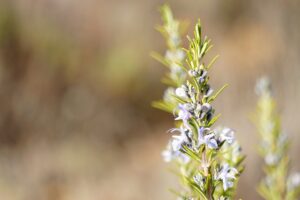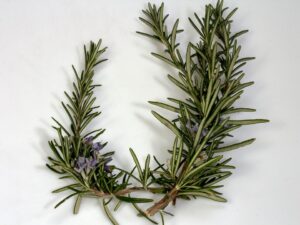 Rosmarinus Officinalis (Rosemary) Leaf Extract*
Rosmarinus Officinalis (Rosemary) Leaf Extract*
A flavoring and perfume from the fresh aromatic flowering tops of the evergreen shrub grown in the Mediterranean. Widely used in hair products, bubble baths, body and hand preparations, lipsticks, suntan products, perfumes and bath soaps.
The Plant
Rosemary is a woody, perennial herb with fragrant evergreen needle-like leaves. It is native to the Mediterranean region. It is a member of the mint family Lamiaceae, which also includes many other herbs. Forms range from upright to trailing; the upright forms can reach 1.5 m tall, rarely 2 m. The leaves are evergreen, 2-4 cm long and 2-5 mm broad, green above, and white below with dense short woolly hairs. The flowers are variable in color, being white, pink, purple, or blue.
The name rosemary has nothing to do with the rose or the name Mary, but derives from the Latin name rosmarinus, which literally means “dew of the sea”, though some think this too may be derived from an earlier name.
 The fresh and dried leaves are used frequently in traditional Mediterranean cuisine as a herb; they have a bitter, astringent taste, which complements oily foods, such as lamb and oily fish. A tisane can also be made from them. They are extensively used in cooking, and when burned give off a distinct mustard smell, as well as a smell
The fresh and dried leaves are used frequently in traditional Mediterranean cuisine as a herb; they have a bitter, astringent taste, which complements oily foods, such as lamb and oily fish. A tisane can also be made from them. They are extensively used in cooking, and when burned give off a distinct mustard smell, as well as a smell
similar to that of burning which can be used to flavor foods while barbecuing.
Rosemary, in the dried form, is extremely high in iron, calcium, and Vitamin B6. It is in fact more nutrient rich in its dry form than fresh rosemary across the board.
Since it is attractive and tolerates some degree of drought, it is also used in landscaping, especially in areas having a Mediterranean climate. It can in fact die in over-watered soil, but is otherwise quite easy to grow for beginner gardeners. It is very pest-resistant.
Rosemary is easily pruned into shapes and has been used for topiary. When grown in pots, it is best kept trimmed to stop it getting too straggly and unsightly, though when grown in a garden, rosemary can grow quite large and still be attractive. It can be propagated from an existing plant by clipping a shoot 10-15 cm long, stripping a few leaves from the bottom, and planting it directly into soil.
Rosemary infusion is used to lighten blond hair, to condition, tone and strengthen all hair. It can also be used as an invigorating toner and astringent. Rosemary used in the bath strengthens and refreshes, especially when used following an illness.
Rosemary helps to relax muscles, including the smooth muscles of the digestive tract and uterus. Because of this property it can be used to soothe digestive upsets and relieve menstrual cramps. Finally, several studies done in the last several years show that oil from the leaves of the very plant can help prevent the development of cancerous tumors in laboratory animals.





